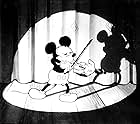Adicionar um enredo no seu idiomaMickey comes onstage to the applause of an unseen audience and plays various classical tunes on the violin, after some minor mishaps. During a sad song, he is overcome with emotion and has t... Ler tudoMickey comes onstage to the applause of an unseen audience and plays various classical tunes on the violin, after some minor mishaps. During a sad song, he is overcome with emotion and has to stop.Mickey comes onstage to the applause of an unseen audience and plays various classical tunes on the violin, after some minor mishaps. During a sad song, he is overcome with emotion and has to stop.
- Direção
- Artista
- Mickey Mouse
- (narração)
- (não creditado)
Avaliações em destaque
The story isn't particularly engaging, and very little is really going on, we are mostly watching Mickey play violin on stage. Most of the interesting stuff, the heckling etc, is happening off screen. There are a few minor mishaps throughout the performance that are designed to get a chuckle out of the audience, but overall it's very mundane in terms of the actual cartoon.
However, compared to some of the other animation studios at this time, you can still see how ahead of his time Walt Disney was, even at this early stage. If we compare it to WB and the early Bosko cartoons, there are a lot less repeated frames, a lot more of a coherent plot, and the backgrounds and characters have a lot more detail to them. A great precursor to the work that he would become renowned for in a few decades time.
Not much of a story here, but definitely there's music to your ears.
Grade C+
It's JUST MICKEY alone on stage as he gives a solo violin recital.
The Mouse has this little black & white film all to himself - no other characters appear on camera. The plot consists entirely of Mickey performing his longhair music and responding to the unseen audience and it is very funny. The three selections are the Hungarian Rhapsody No. 2 by Liszt, Schumann's Träumerei and the Finale to Rossini's William Tell Overture.
Walt Disney (1901-1966) was always intrigued by drawings. As a lad in Marceline, Missouri, he sketched farm animals on scraps of paper; later, as an ambulance driver in France during the First World War, he drew figures on the sides of his vehicle. Back in Kansas City, along with artist Ub Iwerks, Walt developed a primitive animation studio that provided animated commercials and tiny cartoons for the local movie theaters. Always the innovator, his ALICE IN CARTOONLAND series broke ground in placing a live figure in a cartoon universe. Business reversals sent Disney & Iwerks to Hollywood in 1923, where Walt's older brother Roy became his lifelong business manager & counselor. When a mildly successful series with Oswald The Lucky Rabbit was snatched away by the distributor, the character of Mickey Mouse sprung into Walt's imagination, ensuring Disney's immortality. The happy arrival of sound technology made Mickey's screen debut, STEAMBOAT WILLIE (1928), a tremendous audience success with its use of synchronized music. The SILLY SYMPHONIES soon appeared, and Walt's growing crew of marvelously talented animators were quickly conquering new territory with full color, illusions of depth and radical advancements in personality development, an arena in which Walt's genius was unbeatable. Mickey's feisty, naughty behavior had captured millions of fans, but he was soon to be joined by other animated companions: temperamental Donald Duck, intellectually-challenged Goofy and energetic Pluto. All this was in preparation for Walt's grandest dream - feature length animated films. Against a blizzard of doomsayers, Walt persevered and over the next decades delighted children of all ages with the adventures of Snow White, Pinocchio, Dumbo, Bambi & Peter Pan. Walt never forgot that his fortunes were all started by a mouse, or that simplicity of message and lots of hard work always pay off.
Você sabia?
- Curiosidades"Fiddling Around" or alternatively know as "Just Mickey" from 1930 is the first Mickey Mouse Cartoon distributed by Columbia Pictures.
- Citações
Mickey Mouse: [to the audience] As an encore, I will play the finale from the Overture of William Tell.
Heckler in the Crowd: Ha, ha, ha!
Mickey Mouse: [to the heckler] Nyeh, nyeh, nyeh!
Heckler in the Crowd: *Raspberries*
- ConexõesEdited into The Mickey Mouse Anniversary Show (1968)
- Trilhas sonorasTraumerei
Principais escolhas
Detalhes
- Tempo de duração7 minutos
- Cor
- Proporção
- 1.37 : 1
Contribua para esta página

















